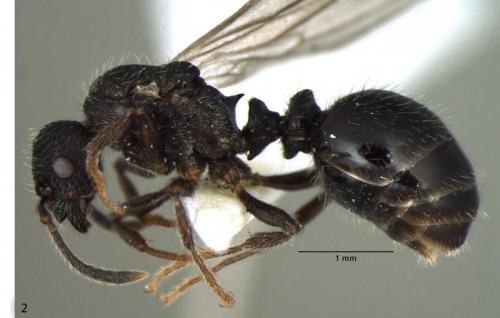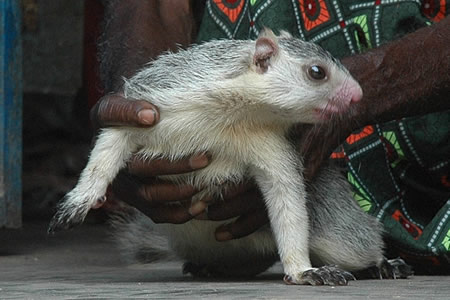What is your first reaction when you see an ant? Brush it off, trample it, or take the insecticide spray out to kill it envisioning hundred more all around. If you are not Dr. Himender Bharti, you will probably say yes to all three. But for this man fascinated by the ant world, a single miniscule ant is the answer to millions of puzzling questions, related to their lifestyle, ecology, evolution and conservation of the forests at large. India’s Endangered spoke to the only scientist working in India with the ants – for the ants 24 X 7. Read and you might just wish to make friends with these misunderstood little life forms.
Ants are all around us and yet hardly noticeable. Call it because of their pint sized appearance or callous reputation of being classified as pests, we humans hardly tend to take interest in these miniature super organisms. And yet, between us and the ants there is an important common thread. Like humans ants too are social animals. They survive by living in colonies and communities just as we do with a social hierarchy of a queen ant, male ants and innumerable female worker ants. It is this virtual thread that ties us that has inspired Dr. Himender Bharti to dedicate his life’s work to ants.
A Life with Ants
Dr.Himender Bharti, is not an unknown name in the myrmecology world – the science of study of ants. His is a passion that has been recognised by numerous scientific organisations and government bodies including the Ministry of Environment and Forests of India. But ask him how it all began and the researcher is quick to name one man – Dr. Edward Wilson.
Edward Wilson is an ant biologist and the author of the first comprehensive book ‘Ants’ that was awarded the prestigious Pulitzer prize for general non-fiction in 1991.
Dr. Bharti says,
“I was inspired by Dr. Edward Wilson’s work. Ants are social insects, they live in colonies and have a social hierarchy. It is this similarity with humans that fascinated me so I began working on ants, exclusively.”
There are about 12,000 known species of ants globally found in different habitats.
According to the website antdiversityindia.com which is run by Dr. Bharti, social organization of ants is orchestrated by intricate chemical communication. As central players in many ecosystems their species composition gives an indication of ecosystem health and functioning; while some are purists reliant on undisturbed ecosystems, others are weeds or even invasive. Their abundance and varied ecological roles make them influential in agricultural ecosystems around the world.
Discovering the Robber Ant
The researcher has extensively studied different species of ants across India, but his special focus has been the Western Ghats and the Shivalik range of mountains in the Himalayas. When asked how many species of ants he has discovered so far, the humble scientist nonchalantly replies, more than 50 species in the Western Ghats and the Himalayas.
India is home to about 660 species of ants, and Dr. Bharti is the man behind discovering almost 8 percent of these known species, till date!
His greatest discovery however and his favourite ant species is the one he found in Solang, Himachal Pradesh in 2012. It is the species called Myrmica nefaria or what is more commonly known as the (robber) ant.

“There are many endemic ants found in India especially in the high altitude region. One such ant is the Myrmica nefaria (robber) ant,” says the expert about his latest find.
When asked why such a curious name given to the ant, he laughs and says,
“Because they are social parasites. These kinds of ants are very rare and a red list species. The parasitic behaviour in general is not common in ants. This particular species resembles its host species Myrmica rupestris. It lives in the host’s nest, uses its resources and even the worker ants. They are totally dependent on the host species.”
The scientist has spent many years researching ants in the Western Ghats, which he says has a similar climate like in Sri Lanka and therefore various common ant species too. But his personal affection is for the ants of the high altitude region not just because of the extreme cold in which these ants survive, but also because many are endemic to the region and extremely special to India.
He is currently studying ants of high altitude region 2000 m above sea level to note their evolution, behaviour and also mapping their molecular gene to understand the evolution pattern.
Ant Conservation = Nature Conservation
In a country obsessed with tigers, do ants even figure as far as conservation actions are concerned? Sadly, no says the expert. But instead of being cynical, Dr. Bharti has launched his own conservation drive.

Along with other like minded ant biologists from across the world Dr. Bharti has proposed an IUCN ant specialist group with an ant conservation plan. The group’s task include identifying different ant species, classifieying them, understand their habitats and habitat needs, highlight the main threats to their ecosystem and thus the ants among other things.
Dr. Bharti believes ants to be a major indicator of the health of an ecosystem.
He explains,
“When we study an area to look for ants, we divide it into groups like primary forest area, secondary forest area and non-forest area. Now when a particular ant species is found in a primary forest area only, it indicates that they can survive only here. They need a thick canopy of forest around them. Therefore if there is a forest there will be the ants. So the absence of a particular ant in a forest cover will easily indicate that the ecosystem is depleting.”
Ants are creatures of habit, just like most other living forms of the world. Some specific species found by Dr. Bharti live in leaf litter and these he calls specialist predators. So if the litter vanishes automatically the ant will too.
“Specific ant species can also be categorised into different groups like climate indicators, habitat indicators, invasive species indicators etc. Therefore it is sad to call them just ant sized creatures when they play such a big role in the environment,” says the scientist.
He adds,
“In India only flagship species are discussed. People are attracted to big and beautiful species. Ants are not even worth looking at though they are super organisms.”
Edward Wilson had said in his acclaimed book,
‘Ants make up two-thirds of the biomass of all the insects. There are millions of species of organisms and we know almost nothing about them.’
Hopefully, the passion of one Indian to change the way India and the world sees ants will change our individual perspective too and we will appreciate these little big marvels a bit more.
You can know more about Dr. Himender Bharti and his work through his website Ants of India
You can also directly contact him,
Dr.Himender Bharti,
Ant Systematics and Molecular Biology Lab.
Department of Zoology and Environmental Sciences,
Punjabi University Patiala,
Punjab, India,147002
Mail – himenderbharti@antdiversityindia.com
More Related Stories,
Carnivorous Plants Emit Blue Glow to Attract Prey
Research Centre to Study Spiders
Himalayan Bird to Get Advanced Breeding Centre
Image via cc/Flickr by Bulldog Pottery. Other images copyright (c) of Dr. Himender Bharti, used with permission.











Good article about ants. They also need attention like bigger members of our planet.
Absolutely Mahesh. Every nature’s creation deserves to get attention whether it is big or small.
The red ants are common in Tamilnadu and they are known in tamil as “Musudu” Thier sting is extremely painful and so many farmers eradicated them. They close large leaves (Particularly mango leaves) into foot ball shaped nests and breed in them. As they run through the earth soil becomes loose and the dead ants are manure to the soil, as the ants naturally die in a month or so.
Thank you for giving this valuable and interesting information. It is often animals and plants that pester us, attack us that we try to eradicate as soon as possible. Whereas the animal, insect is only trying to defend itself. Each organism howsoever small it might be is of value, if only we recognise it.